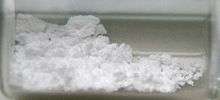Europium(III) oxide
Europium(III) oxide (Eu2O3), is a chemical compound of europium and oxygen. It is widely used as a red or blue phosphor in television sets and fluorescent lamps, and as an activator for yttrium-based phosphors. It is also an agent for the manufacture of fluorescent glass. Europium fluorescence is used in the anti-counterfeiting phosphors in Euro banknotes.[2]
 | |
| Identifiers | |
|---|---|
3D model (JSmol) |
|
| ChemSpider | |
| ECHA InfoCard | 100.013.787 |
PubChem CID |
|
| UNII | |
CompTox Dashboard (EPA) |
|
| |
| |
| Properties | |
| Eu2O3 | |
| Molar mass | 351.926 g/mol |
| Appearance | white to light-pink solid powder |
| Odor | odorless |
| Density | 7.42 g/cm3 |
| Melting point | 2,350 °C (4,260 °F; 2,620 K)[1] |
| Boiling point | 4,118 °C (7,444 °F; 4,391 K) |
| Negligible | |
| +10,100·10−6 cm3/mol | |
| Thermal conductivity | 2.45 W/(m K) |
| Structure | |
| Monoclinic, Cubic | |
| Hazards | |
| Safety data sheet | External MSDS |
| Lethal dose or concentration (LD, LC): | |
LD50 (median dose) |
5000 mg/kg (rat, oral) |
| Related compounds | |
Other anions |
Europium(III) chloride |
Other cations |
Samarium(III) oxide, Gadolinium(III) oxide |
Except where otherwise noted, data are given for materials in their standard state (at 25 °C [77 °F], 100 kPa). | |
| Infobox references | |
Europium oxide has two common structures: Monoclinic (mS30, SpaceGroup = C2/m, No. 12) and cubic (cI80, SpaceGroup = Ia-3, No. 206). The cubic structure is similar to that of manganese(III) oxide.
It may be formed by ignition of europium metal.
It can react with acids to form the corresponding europium(III) salts.
Gallery
 Cubic Eu2O3
Cubic Eu2O3 Monoclinic Eu2O3
Monoclinic Eu2O3
gollark: Freeish State of Gollarkia™ tax management systems are impartial and inevitable automated systems mostly immune to memetic assault.
gollark: Your antiantimemetics are untested and unlikely to work, and your drones just sound ridiculous.
gollark: <@319753218592866315> probably.
gollark: Which are no match for my ionic symphonic protonic antimemetic electronics.
gollark: Does it though? Does it really.
This article is issued from Wikipedia. The text is licensed under Creative Commons - Attribution - Sharealike. Additional terms may apply for the media files.